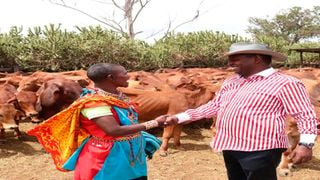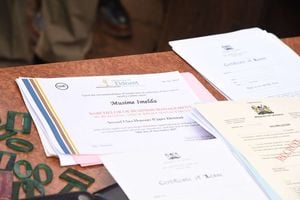
Samburu Governor Moses Lenolkulal hands Sahiwal cows for inter-breeding to Nomotio Livestock Improvement Centre.
| Geoffrey Ondieki | Nation Media GroupSeeds of Gold
Premium
Samburu embraces improved cattle
What you need to know:
- Many locals who have abandoned traditional livestock and opted for improved breeds.
- Sahiwal is one of the best exotic dual-purpose breeds as it can withstand the tropical climate.
Julius Lalampaa is busy cutting fodder at his expansive farm opposite St Paul’s Primary School in Maralal.
Healthy breeds of improved cows contradict the perception of Samburu county residents as nomads rearing indigenous breeds.
He welcomes us to a shade under one of the trees at the far corner of the compound. Lalampaa is one among many locals who have abandoned traditional livestock and opted for improved breeds.
He spends little time explaining why he embraced dairy farming.
Lalampaa says climate change, prolonged droughts and frequent diseases made him lose faith in indigenous cattle breeds.
According to Lalampaa, constant raids by rustlers made rearing of indigenous breeds unsustainable.
“After 40 of my cows were driven away, I had to look for alternative means of livelihood,” he says.
“I could no longer maintain indigenous animals. If the cows are not sick, then they can be easily taken by rustlers.”
The farmer has seven improved cows at his grazing unit. They look healthy and markedly different from the traditional Zebu and Borana animals he once kept.
He says the improved dairy cows have adapted to the tough Samburu county climate.
“I started interbreeding the cows and noticed a huge difference in production. I now feel secure and more stable because these cows have changed the fortunes of my family,” Lalampaa says.
Easy targets of rustlers
A litre of milk in Maralal town goes for Sh60. Lalampaa gets about 100 litres from his improved animals every day.
Considering the high quality of his milk, traders flock Lalampaa’s compound for the produce.
The farmer says he now makes a fortune and expects to make improvements in future.
“I have seen the benefits of improved cattle breeds. My life has changed from the time I ditched the traditional animals. I am now planning to venture into horticulture once irrigation projects by the county government are completed,” Lalampaa says.
A majority of people in Samburu and neighbouring counties keep indigenous animals, making them easy targets of rustlers.
Deep inside Nomotio Agricultural Farm, the county government is attempting to rewrite the script of cattle farming and change the traditional approach – nomadic pastoralism, which involves families shifting from one region to another with their animals in search of water and pasture.
Located 10 kilometres from Maralal, Nomotio Agricultural Farm serves as a breeding centre for livestock.
Animal breeds that are interbred here include Galla goats and Sahiwal cows.
Sahiwal is one of the best exotic dual-purpose breeds as it can withstand the tropical climate of the dry Samburu county.
Traditional cattle breeds
Here, the Seeds of Gold team met Silas Letinina, a herder from Maralal.
“I just want change from indigenous cattle to improved breeds of Sahiwal. That is why I keep bringing my animals here to interbreed,” Letinina says.
After many campaigns by county and national government authorities, pastoralists are moving away from traditional cattle breeds to improved ones in an effort to realise more profits, according to Governor Moses Lenolkulal.
The county boss says his administration is working with local farmers to ensure successful adoption of the new animal breeds to improve family incomes.
Climate change and diminished land sizes have made large scale livestock keeping unreliable, hence the need to embrace modern practices that guarantee high yields.
Governor Lenolkulal says farmers access quality breeds at Nomotio Livestock Improvement Centre at subsidised costs.
“There is great need for farmers to accept changes. Traditional animal husbandry is no longer sustainable,” the governor says.
Lenolkulal urges residents to plant grass and fodder if the livestock improvement programmes are to succeed.
About 95 per cent of Samburu county residents depend on livestock for income, with cattle, sheep, goats and camels making up 92 per cent of the animals.
Improved cattle breeds
“My administration is working closely with local farmers. We conduct trainings and show the how to take care of the new breeds,” Governor Lenolkulal adds.
Traditional animal husbandry has not guaranteed quality meat, milk and other products, according to the governor.
He says the traditional methods have largely contributed to the poverty witnessed in Samburu and neighbouring counties.
He adds that local breeds of cattle cannot meet the dairy and beef needs of the region.
“Samburu county consumes 10 tonnes of beef daily. There is also an external market that we have not exploited despite working tirelessly towards that goal. Our traditional breeds do not calve often and take long to mature,” Governor Lenolkulal says.
Kenya Agriculture Livestock and Research Organisation (Kalro) is also working with the county government to introduce other improved cattle breeds that can easily adapt to the harsh climatic conditions.
Kalro Director-General, Eliud Kireger, says the improved cross between Sahiwal and the exotic Friesian is resistant to a number of pests and diseases.
“One such animal can produce up to 30 litres of milk in one day,” Kireger says.
According to the Kalro boss, improved dairy cow breeds can do well in the nomadic pastoral system of production.





